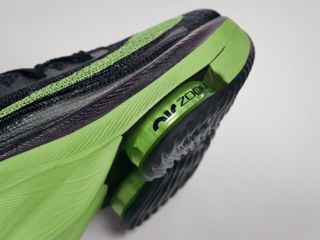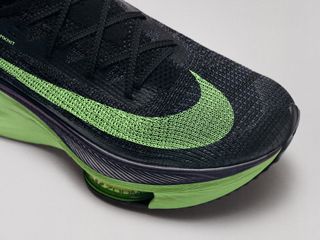Our Verdict
The best long-distance racing shoe available, providing a springy ride that can help you smash your marathon PBs.
For
- Fast, springy ride
- Protective over long races
- Improves running efficiency
Against
- Expensive
- Heavier than some carbon shoes
- Can be a bit unstable
You can trust Coach
After one run, or even just one kilometre in the Nike Vaporfly 4%, the first iteration of Nike’s controversial, record-breaking carbon-plate shoes, I knew it was special and different from pretty much everything I’d tried.
When the next generation Vaporfly NEXT% arrived it took some time for me to accept it really was an upgrade on my beloved 4%, which had carried me to PBs at every distance from 5K to marathon.
When the Alphafly – the consumer version of the shoe Eliud Kipchoge wore when he broke the two-hour marathon barrier – turned up at my door I was initially both very excited and a little sceptical. It’s so big, with a huge stack of cushioning that really doesn’t scream “fast” at you. After one run – an easy 8km with some strides at the end – I was still unsure.
- Newsflash: Nike Air Zoom Alphafly NEXT% 2 limited release announced and we got our hands on it first. Read our Nike Air Zoom Alphafly NEXT% 2 review
A post shared by Coach (@getcoach)
A photo posted by on
However, on my second run I upped the pace, and everything clicked into place. The Alphafly is designed for moving at speed, and once you do it rolls from heel to toe incredibly smoothly and the forefoot practically pops with the new Air Zoom pods in the midsole.

The pods are the biggest change to the Vaporfly NEXT%, which had ZoomX foam throughout the midsole. That foam is a key part of the success of Nike’s carbon-plated shoes, but making the forefoot in the Alphafly firmer with the Air Zoom pods does add a more propulsive feel to your toe-off compared with the Vaporfly.
Another difference is the upper, which is made of AtomKnit, an updated version of the Flyknit Nike uses on many shoes. The AtomKnit upper is featherweight and the open knit means you can see through it, so it ticks the breathability box with a flourish. It’s not as tight as Flyknit but I found the fit secure and true to size, and it feels like it won’t stretch much over time. The toe box also has a reinforced section at the front, which will hopefully stop it wearing down or even ripping in that area.

I’ve used the Alphafly for a wide range of runs and it certainly excels more on some types than on others. I was surprised at how impressive it felt for an all-out 5K, and naturally it was brilliant for a steady half marathon, where the cushioning combined with that carbon plate made holding a good pace just feel easier. I have no doubt it will be a one of the best marathon racing shoes, whenever it’s safe to race marathons again.
When I used it for shorter reps it wasn’t quite so good, however. In a session of six 800m reps sandwiched by two one-mile efforts I found that, near the end of a rep when my form started to suffer, the hefty stack of cushioning did become noticeable again – and in a bad way. If you’re not landing under yourself then that stack can get in the way, so focusing on your form at the end of races will be important in this shoe. It’s fast enough for those short efforts, despite the fact my size 9 (UK) weighs 232g (for comparison my Vaporfly NEXT% in the same size weighs 198g), but the large stack is still a little cumbersome at times.
I have also found that although I’m a neutral runner, my feet roll inwards slightly when running in the Alphafly, to the point that there is more wear on the inside half of the outsole. This isn’t something that happened with the Vaporfly, and while not a big problem – I haven’t experienced any niggles while using the shoe – if you already use a stability shoe or are worried about overpronation in general, the Alphafly might not be perfectly suited to you.
The high stack also means if you’re on a route with a lot of sharp turns or running on cambered or cobbled ground, the Alphafly is a bit wobbly. That might mean the Vaporfly would be the better pick for 5K and 10K races on twisty courses, because it is a little more stable. Over longer distances, however, I think the Alphafly will be better even if you have to be careful on a few turns, thanks to the extra energy return from the Air Zoom pods.
When it comes to durability, there seems to be plenty of rubber on the outsole of the Alphafly and I don’t think it’s a shoe you’ll have to protect and save exclusively for race day. The Vaporfly had that reputation, though I found it was overstated – I’ve used my first pair for hundreds of kilometres without noticing a huge change in the feel. While the price means you’ll probably want to reserve the Alphafly for key training sessions and races, after around 80km of running I’ve seen next to no excessive wear and tear beyond a small patch of fabric getting ripped off on the outsole.
Ah yes, the price. Even in the now very expensive world of top-shelf running shoes the Alphafly stands out. It costs £259.99, which is £20 more than the Vaporfly NEXT%. It’s also £70 more than the new Saucony Endorphin Pro, which is designed to rival Nike’s best racing shoes. I’ve just started testing the Endorphin Pro and after 40km I’m impressed. It’s a more stable, versatile shoe that might not have the bounce and pop of the Alphafly, but is still lightning fast.
However, if I had a marathon tomorrow I’d reach for the Alphafly. Despite the caveats, it’s the supreme long-distance racer out there, and would be a great option for shorter events too. There are more brands offering excellent alternatives now, but Nike still has the top option for PB hunters.

Nick Harris-Fry is a journalist who has been covering health and fitness since 2015. Nick is an avid runner, covering 70-110km a week, which gives him ample opportunity to test a wide range of running shoes and running gear. He is also the chief tester for fitness trackers and running watches, treadmills and exercise bikes, and workout headphones.

How To Watch The London Marathon 2024 On TV Or A Live Stream

“The PBs Have Always Been Secondary, I Just Enjoyed Running”—How Anya Culling Took Two Hours Off Her First London Marathon Time

This Expert PT Recommends Kettlebell Training For Strength, Power And Cardio Gains—And These Are The Six Exercises To Master First
